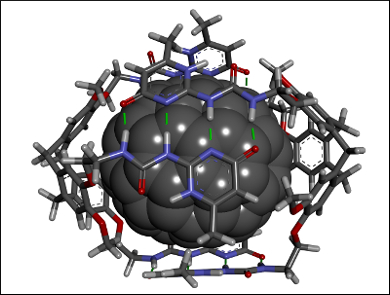Special self-assembled dimeric capsules can effectively separate higher fullerenes without using chromatography. The capsules selectively capture the fullerenes due to favorable host-guest interactions.
Carles Bo, Javier de Mendoza, and colleagues, Barcelona Institute of Science and Technology, Tarragona, Spain, explored the molecular basis of such selectivity by combining theory and experiments. The fullerenes C60, C70, and C84 are readily encaged within a hydrogen-bonded dimeric capsule (pictured). The capsule is based on two concave cyclotriveratrylene (CTV) scaffolds, each containing three self-complementary 2-ureido-4-[1H]-pyrimidinone (UPy) subunits.
These capsule-fullerene complexes were characterized using NMR spectroscopy and circular dichroism (CD) spectroscopy, complemented by dispersion-corrected density functional theory (DFT) calculations. In agreement with the experimental results, the calculations revealed that the encapsulation is most favorable for C84 (on par with C90), and follows the trend C60 < C70 < C76 < C78 < C84 ≈ C90.
- Molecular Basis for the Recognition of Higher Fullerenes into Ureidopyrimidinone-Cyclotriveratrylene Self-Assembled Capsules,
Elisa Huerta, Stefano Artin Serapian, Eva Santos, Enrique Cequier, Carles Bo, Javier de Mendoza,
Chem. Eur. J. 2016.
DOI: 10.1002/chem.201601690




